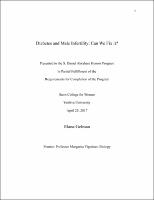Please use this identifier to cite or link to this item:
https://hdl.handle.net/20.500.12202/4067Full metadata record
| DC Field | Value | Language |
|---|---|---|
| dc.contributor.author | Gelman, Elana | - |
| dc.date.accessioned | 2018-11-05T21:03:00Z | - |
| dc.date.available | 2018-11-05T21:03:00Z | - |
| dc.date.issued | 2017-04 | - |
| dc.identifier.uri | https://hdl.handle.net/20.500.12202/4067 | - |
| dc.identifier.uri | https://ezproxy.yu.edu/login?url=https://repository.yu.edu/handle/20.500.12202/4067 | |
| dc.description | The file is restricted for YU community access only. | - |
| dc.description.abstract | Diabetes mellitus (DM) is a disorder that has become one of the most pressing medical issues currently plaguing our modern society. Not only are the health risks severe, the disease is chronic, with symptoms worsening with age (Coman et al., 2012). In addition, DM is currently outpacing the incidence of most other diseases on the global scale. The World Health Organization (WHO), in 2000, released a report that 177 million people worldwide were affected by DM. The WHO also projected that by the year 2025, this number would almost double to 300 million people (WHO, 2002). This increase can be attributed to factors like population growth, lack of physical activity obesity, urbanization, and aging (Wild et al., 2004). | en_US |
| dc.description.sponsorship | S. Daniel Abraham Honors Program | en_US |
| dc.language.iso | en_US | en_US |
| dc.publisher | Stern College for Women | en_US |
| dc.rights | Attribution-NonCommercial-NoDerivs 3.0 United States | * |
| dc.rights.uri | http://creativecommons.org/licenses/by-nc-nd/3.0/us/ | * |
| dc.subject | Diabetes. | en_US |
| dc.subject | Male reproductive health. | en_US |
| dc.subject | Infertility, Male. | en_US |
| dc.title | Diabetes and Male Infertility: Can We Fix it? | en_US |
| dc.type | Thesis | en_US |
| Appears in Collections: | S. Daniel Abraham Honors Student Theses | |
Files in This Item:
| File | Description | Size | Format | |
|---|---|---|---|---|
| Elana-Gelman.pdf Restricted Access | 377.26 kB | Adobe PDF |  View/Open |
This item is licensed under a Creative Commons License

